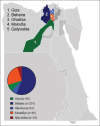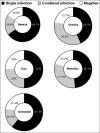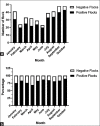Epidemiological distribution of respiratory viral pathogens in marketable vaccinated broiler chickens in five governorates in the Nile Delta, Egypt, from January 2022 to October 2022
- PMID: 38595666
- PMCID: PMC11000479
- DOI: 10.14202/vetworld.2024.303-312
Epidemiological distribution of respiratory viral pathogens in marketable vaccinated broiler chickens in five governorates in the Nile Delta, Egypt, from January 2022 to October 2022
Abstract
Background and aim: Respiratory viral infections significantly negatively impact animal welfare and have significant financial implications in the poultry industry. This study aimed to determine the frequency of the most economically relevant respiratory viruses that circulated in Egyptian chicken flocks in 2022.
Materials and methods: Chickens from 359 broiler flocks in five different Egyptian governorates in the Nile Delta (Beheira, Gharbia, Giza, Monufiya, and Qalyoubia) at marketing time (33-38 days of age) were used in this study. Combined oropharyngeal and cloacal swabs and tissue samples were collected from clinically diseased or freshly dead birds suffering from respiratory disease. Avian influenza (AI)-H5, AI-H9, Newcastle disease (ND), and infectious bronchitis virus (IBV) were analyzed by reverse transcriptase polymerase chain reaction.
Results: Of the 359 flocks examined, 293 tested positive, whereas 66 were completely negative for the four viruses evaluated, with the highest positive results in Beheira. Out of 293 positive flocks, 211 were positive for a single virus, with Beheira having the highest rate, followed by Qalyoubia, Giza, and Monufiya. ND virus (NDV) was found to be the highest across all governorates, followed by IBV, AI-H9, and AI-H5. A double infection was detected in 73 flocks with either H9 or ND, or both H9 and IB could coinfect each other. The most common viral coinfections were H9 + IB, ND + IB, and ND + H9. Giza had the highest prevalence of ND + H9, H9 + IB, and ND + IB coinfection in the governorates, followed by Monufiya and Beheira. Only six out of 359 flocks were tribally infected with ND + H9 + IB in Giza, Monufiya, and Beheira governorates. On the basis of the number of flocks and the month of the year, July had the lowest number of flocks (23), while September and October had the highest number (48 flocks). Positive flock numbers were highest in October and lowest in January.
Conclusion: From January to October 2022, prevalent respiratory viral infections (H5N1, NDV, H9N2, and IBV) were detected in broiler chickens across the Delta area governorate, according to the findings of the present study. In addition, IBV and H9, either alone or in combination, significantly contributed to the respiratory infection observed in broiler chickens. Regardless of the type and origin of the vaccine used, it is not possible to protect broiler chickens from the development of the infection and the subsequent dissemination of the virus into the poultry environment. In the presence of face-infectious field virus mutations, poultry vaccinations must be regularly reviewed and updated, and poultry farms must take further biosecurity measures.
Keywords: Egypt; Newcastle disease; avian influenza virus; chicken; infectious bronchitis; reverse transcriptase polymerase chain reaction; subtype H5 and H9.
Copyright: © El-Shemy, et al.
Conflict of interest statement
The authors declare that they have no competing interests.
Figures






Similar articles
-
Prevalence of avian respiratory viruses in broiler flocks in Egypt.Poult Sci. 2016 Jun 1;95(6):1271-80. doi: 10.3382/ps/pew068. Epub 2016 Mar 14. Poult Sci. 2016. PMID: 26976895 Free PMC article.
-
Molecular survey and interaction of common respiratory pathogens in chicken flocks (field perspective).Vet World. 2019 Dec;12(12):1975-1986. doi: 10.14202/vetworld.2019.1975-1986. Epub 2019 Dec 16. Vet World. 2019. PMID: 32095050 Free PMC article.
-
Investigation of suspected Newcastle disease (ND) outbreaks in Egypt uncovers a high virus velogenic ND virus burden in small-scale holdings and the presence of multiple pathogens.Avian Pathol. 2019 Oct;48(5):406-415. doi: 10.1080/03079457.2019.1612852. Epub 2019 Jul 25. Avian Pathol. 2019. PMID: 31090444
-
Co-infections, genetic, and antigenic relatedness of avian influenza H5N8 and H5N1 viruses in domestic and wild birds in Egypt.Poult Sci. 2019 Jun 1;98(6):2371-2379. doi: 10.3382/ps/pez011. Poult Sci. 2019. PMID: 30668795 Free PMC article.
-
Respiratory disease complex due to mixed viral infections in chicken in Jordan.Poult Sci. 2024 Apr;103(4):103565. doi: 10.1016/j.psj.2024.103565. Epub 2024 Feb 16. Poult Sci. 2024. PMID: 38417340 Free PMC article. Review.
Cited by
-
Review of respiratory syndromes in poultry: pathogens, prevention, and control measures.Vet Res. 2025 May 17;56(1):101. doi: 10.1186/s13567-025-01506-y. Vet Res. 2025. PMID: 40382667 Free PMC article. Review.
References
-
- Collett S.R, Smith J.A, Boulianne M, Owen R.L, Gingerich E, Singer R.S, Johnson T.J, Hofacre C.L, Berghaus R.D, Stewart-Brown B. Principles of disease prevention, diagnosis, and control. Dis. Poult. 2020;2020:1–78.
-
- Roussan D.A, Haddad R, Khawaldeh G. Molecular survey of avian respiratory pathogens in commercial broiler chicken flocks with respiratory diseases in Jordan. Poult. Sci. 2008;87(3):444–448. - PubMed
LinkOut - more resources
Full Text Sources
